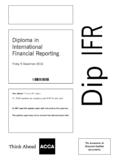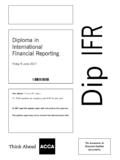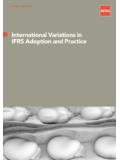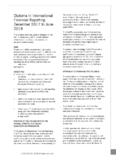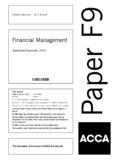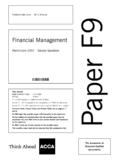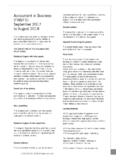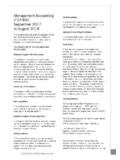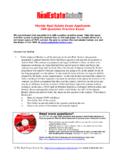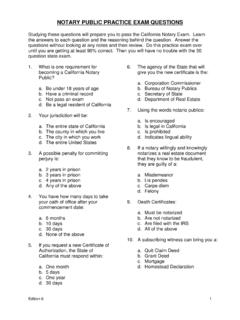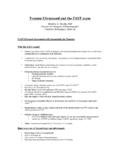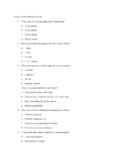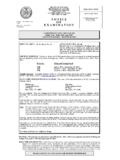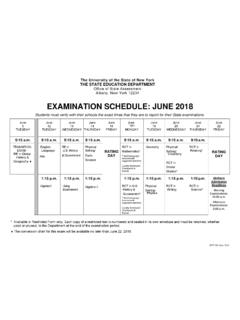Transcription of P2 exam report - ACCA Global
1 Examiner s report P2 Corporate Reporting June 2013 Examiner s report P2 June 2013 1 General Comments The examination consisted of four questions. Section A contained the compulsory question 1 for 50 marks and section B comprised three further questions of 25 marks from which the candidate had to choose 2 questions. Most candidates attempted three questions, and there was little evidence of time pressure. Where questions were left unanswered by candidates, this appeared to be due to a lack of knowledge or poor exam technique and limited the marks available for that candidate.
2 In previous diets, there have been comments about the importance of answering all parts of all questions. Many candidates answered question 1 first but there is no real ideal way of answering the paper other than completing all parts in a way, which suits the candidate s learning style. There is always comment in examiners reports about exam technique and lack of it by candidates. Exam technique consists of a few simple procedures that can help the candidate immeasurably. Many candidates have not been instructed in these techniques.
3 Answers should have a structure and cover points in an organised way. It may be best to write less on each point, leave out some of the background knowledge but focus on the facts/scenario in the question. The examiner does not need to know, for example, the role of the IASB in standard setting unless specifically asked in the question but often candidates may outline this as an introduction to an answer. I am not advocating writing less in the examination but making the answer more relevant. There is a need to include analysis of the points being raised and to reflect upon them analytically or critically.
4 Candidates should show an understanding of different, and possibly opposing, points of view. There is always a model solution to the question but in practice there are always opposing viewpoints, and candidates should not be afraid of expressing these viewpoints as they will not be penalised if the rationale is acceptable. The questions are not written to trick candidates but it is important to read the question carefully. Always ask yourself, is what I am including relevant to the question? Successful candidates demonstrate relevant knowledge by using ideas and concepts from recommended accounting practice.
5 Practical examples from reading current articles are important ways of supporting the points made. Candidates should try and use proper sentences and paragraphs rather than bullet points, as this will contribute to the awarding of professional marks. Candidates should never use abbreviations of words such as text language. This subject area lends itself to spaced learning and not massed learning. It is important to relate the learning to practical events and it is evident from the answers to the questions that candidates are finding it difficult to recall and apply the relevant facts.
6 Many candidates simply set out everything they know, hoping that some of the material is relevant. There is a need for a broader understanding rather than rote-learnt facts. This will only arise if candidates space out their learning and fully understand different parts of the syllabus as they learn. Specific Comments Question One This question required candidates to prepare a group consolidated statement of financial position. The group was a complex group with candidates being required to determine the nature of the group holdings and the dates on which control occurred.
7 The partial goodwill method was used by the entity and there was an impairment calculation required also. The group made a loan to a charitable organisation for the building of new sporting facilities and candidates had to deal with the financial asset, which had a subsidised rate of interest. The discounted interest rate was recognised as a reduction in the fair value of the asset when measured for the first time thus reflecting the economic substance of the transaction. There were additional adjustments required for the following: The acquisition of office accommodation where the fair value of the accommodation fell and was reflected in the financial statements but the market recovered unexpectedly quickly with the result that the offices should be valued upwards.
8 Examiner s report P2 June 2013 2 The announcement of two major restructuring plans with no entries having been made in the financial statements for the plans. The accounting for the group pension plan where the figures had not been taken into account for the year except for the contributions paid which have been entered in cash and the defined benefit obligation. Candidates generally score well on question 1. The goodwill calculations were invariably correct as was the nature of the group relationships.
9 The treatment of the office accommodation was well answered as was the pension element. Surprisingly the restructuring costs were not particularly well dealt with by candidates. Only those costs that result directly from and are necessarily entailed by the restructuring may be included, such as employee redundancy costs or lease termination costs. Expenses that relate to ongoing activities, such as relocation and retraining are excluded. With regard to the service reduction, a provision should have been recognised for the redundancy and lease termination costs.
10 In contrast, the group should not have recognised a provision for the finance and IT department s re-organisation, as the re-organisation was not due to start for two years. Candidates had problems with the discounting of the loan to the charitable organisation. They often confused the principles involved, not realising that the fair value of the asset should be reduced for the subsidised rate of interest. There are a significant number of marks attached to the retained earnings, OCI and NCI calculations. The marking scheme for these elements of the answer is based mainly around the candidates own figures.

